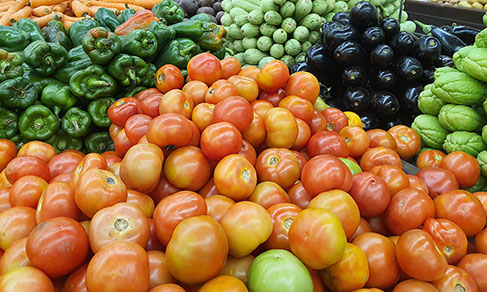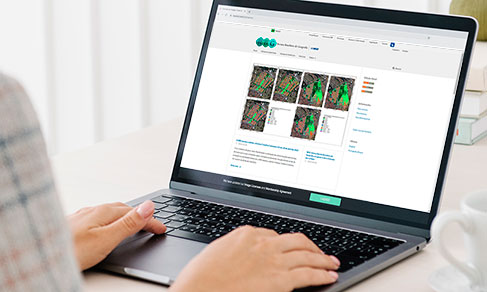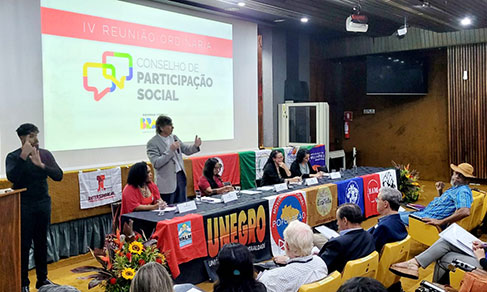SDG
IBGE releases study on SDG indicators and G20; new version of Geographic School Atlas; and 2023 Management Report
April 09, 2024 04h00 PM | Last Updated: April 16, 2024 12h22 PM
Highlights
- The IBGE has made an effort to produce global indicators for monitoring the 2030 Agenda in the country, in collaboration with other institutions that produce official data
- Considering the poverty line of US$ 2.15/day, India, Brazil and Indonesia presented, in 2021, the highest proportions of persons in poverty, among the G20 countries that reported the indicator, with a decrease being observed in 2022 in Brazil (from 5.8 to 3.5%) and Indonesia (3.5 to 2.5%);
- In 2021, no G20 country that reported the indicator had achieved universal coverage of secondary education completion, considering persons aged 20 to 22 years old. In the United States, the rate reached 94.58%, while in Mexico it was 59.53% and in Brazil, 73.37%.
- Mexico, South Africa and Argentina are the G20 countries with the highest representation of women in national parliaments. In Brazil, the participation of women is only 14.81%. In terms of the proportion of women in managerial positions, Brazil ranks third, behind only the USA and Russia;
- India, Indonesia, Mexico, Argentina, South Africa and Brazil have the highest rates of informal employment. While in India the rate is 91.32% for women, in Germany it is 4.61%
- The unemployment rate is bigger among the population aged 15 to 24 in all G20 countries.
- The publication "Creating Synergies between the 2030 Agenda for Sustainable Development and the G20: Inequalities Module - First Analyses" will be launched at an event at Casa G20 - Casa de Cultura Laura Alvim, in Ipanema, in the city of Rio de Janeiro (RJ), broadcast via the IBGE Portal at 4 pm.

This Tuesday, the 9th, the IBGE releases: the publication "Creating Synergies between the 2030 Agenda for Sustainable Development and the G20: Inequalities Module - First Analyses", a study that sought to match the agendas of the G20 and of the Sustainable Development Goals (SDGs): the 9th edition of the IBGE School Geographic Atlas (Atlas Geográfico Escolar do IBGE), a reference for students across the country, with geographic, cartographic and statistical data, and the world map, developed by the IBGE, which places Brazil in the center of it and highlights the countries that make up the G20, those that have Brazilian diplomatic representation, in addition to some basic information about Brazil, such as population and area, among other data. The 2023 Management Report (Relatório de Gestão 2023) is also brought to the public on this date.
These products will be announced at an event at Casa G20 - Casa de Cultura Laura Alvim, in Ipanema, in the city of Rio de Janeiro (RJ), broadcast live on the IBGE website and on all of the Institute's social media at 4 pm. The event is held in partnership with the Secretariat of Culture and Creative Economy, Secretariat of Environment and Sustainability, State Institute of the Environment, bodies of the Government of the State of Rio de Janeiro, in addition to G20 Brazil and Rio 2030 promoted by the Sustainable Development State Authority in Rio de Janeiro.
SDG Agenda and G20
The Institute has made an effort to produce global indicators for monitoring the 2030 Agenda in the country, in a collaborative manner with other institutions that produce official data, and having representation in several international groups on the topic.
The coordinator of the SDG Project at the IBGE Presidency, Denise Kronemberger, explains that the disaggregation of data for the SDG indicators is fundamental for the implementation of the 2030 Agenda, as it allows capturing the population in vulnerable situations and inequalities, and then fighting against them through public policies. The product resulting from this collaborative effort is the SDG Brazil Platform, which currently provides a set of 125 indicators for the monitoring the 2030 Agenda in Brazil.
“The indicators follow internationally established methodologies and standards and are calculated with official national data produced regularly. With this publication, the IBGE brings to the debate the synergies that exist between the 2030 Agenda and the G20, providing a first set of information that can support discussions on the topic of inequalities, which will take place within the scope of working groups and task forces, as well as at the G20 Social and at the Summit itself, to be held in November”, says Ms. Kronemberger.
The publication brings seven global indicators of the Sustainable Development Goals (SDGs), which present a portrait of inequalities between G20 countries, using the most recent information available for most countries. Following this, there are 17 indicators produced for Brazil and Major Regions, relating to seven SDGs, which show the importance of disaggregating data when revealing inequalities in the most varied dimensions (income, gender, color or race, age groups, people with disabilities and regional inequalities).
India, Brazil and Indonesia have the highest proportions of population below the poverty line
The SDG 1.1.1 indicator, “Proportion of the population living below the
international poverty line”, reveals that among the G20 countries that have information in the Global SDG Indicator Database, considering the poverty line of US$ 2.15/day, India (12.9%), Brazil (5.8%) and Indonesia (2.5%) had the highest proportions of persons in poverty in 2021. There was a decrease in 2022 in Brazil (3.5%) and Indonesia (2.5%). There is no 2022 data for India. The indicator also makes disparities stand out: in 2021, while India had 12.9% of the population below the international poverty line, the proportion in France was 0.1%, and 0.2% in the United States and the United Kingdom.
In relation to access to education (SDG 4), the study shows that, in 2021, no country in the G20, which produces the indicator, achieved universal coverage of secondary education completion, considering persosn aged 20 to 22 years old. In the USA, the rate reached 94.58%; while in Mexico it was 59.53% and in Brazil, 73.37%.
Mexico, South Africa and Argentina have greater representation of women in national parliaments
Indicator 5.5.1, “Proportion of seats held by women in
national parliaments, indicates that Mexico (50%), South Africa (46.72%) and Argentina (44.95%) are the G20 countries with the highest representation of women in national parliaments. In several countries the gap to reach equal representation is greater: Japan (9.68%), Brazil (14.81%) and India (14.94%). Regarding indicator 5.5.2, “Proportion of women in managerial positions”, among the countries that have the indicator, Brazil (38.8%) occupies the third position, only behind Russia (46.2%) and USA (41.4%).
SDG 8 (economic growth) indicators reveal that the informal employment rate in India, Indonesia, South Africa, Turkey and Germany is higher among women. While in India the rate is 91.32% for women, in Germany it is 4.61%.
The unemployment rate is higher among the population aged 15 to 24 in all G20 countries that present information for the indicator. Among women in this age group, the highest values occur in South Africa (53.85%), Saudi Arabia (26.41%), Italy (25.81%) and Turkey (25.71%). Among the population aged 25 and over, the highest rates are recorded for men (24.73%) and women in (27.42%) South Africa and for women in Saudi Arabia (13.98%). The biggest differences in the unemployment rate by sex in this age group occur in Saudi Arabia (12.13 pp), Turkey (3.57 pp) and Brazil (3.43 pp).
In 2021, the number of homicides was the highest in two decades, moslty affecting men
In the case of SDG 16 (Promoting peace), according to the latest UN report for the SDGs, 2021 was the year that presented the highest number of intentional homicides in the world in relation to the last two decades. Among the 15 G20 countries with information on the number of homicide victims, South Africa, Mexico and Brazil had the highest figures in 2021. Homicide victims are much higher among men. In South Africa, 72.04 male victims/100 thousand population were recorded, while in Japan the figure was 0.25, also for men. The global rate was 5.8/100,000, also in 2021, with 9.3 for men and 2.2 for women.
Inequality in Brazil moslty affects youngsters and rural population
The publication "Creating Synergies between the 2030 Agenda for Sustainable Development and the G20: Inequalities Module - First Analyses", brings a study of inequality focusing on the Brazilian case. SDG 1, No poverty, shows that in Brazil monetary poverty is concentrated among younger population, up to 17 years of age (46.6% below the poverty line). The proportion of the population below the national poverty line, according to geographic location, is higher in rural areas, 38.7% compared to 15.3% in urban areas. The Non-Monetary Multidimensional Poverty Index shows that, despite the reduction, poverty is concentrated in the North (5.2%) and Northeast (4.3%) Regions.
Deaths by suicide increases in all Major Regions
Regarding SDG 3 (health and well-being), there was a reduction in the mortality rate of live births during the first five years of life, between 2000 and 2022, in all Major Regions of Brazil. The Northeast and North showed the greatest reductions in the mortality rate in children aged under five . In 2000, the Northeast had the highest mortality rate (41.2); in 2022, the position was occupied by the North Region (19.7).
In relation to the suicide mortality rate, in the population aged five or over, there was an increase in all Major Regions, with the greatest increase in the Northeast (171.6%) – going from 2.6 to 7.1 deaths per hundred thousand population. In Brazil as a whole, the increase corresponded to 79.9% - rising from 4.3 in 2000 to 7.8 deaths per hundred thousand population in 2021. Between 2020 and 2021, growth of 11.2% was also observed.
Children and the elderly are the biggest victims of lack of sanitation
There was also a 38.9% reduction in the mortality rate from diseases attributed to unsafe water sources, unsafe sanitation and lack of hygiene and regional inequalities (indicator 3.9.2), although these remain striking. In the Northeast, the rate fell from 9.8 in 2020 to 5.5 in 2021, in the North, the rate fell from 7.7 to 4.8 deaths per 100 thousand population. In 2022, 79.2% of deaths attributed to unsafe water sources, unsafe sanitation and poor hygiene occurred among seniors aged 60 and over.
Education indicators reflect regional and income inequalities
As for SDG 4 (Quality education), in 2022, 89.8% of persons aged 17 to 19 completed primary education. Among the 20% of the population with the highest incomes, the primary education completion rate reached 97.1% and, among the 20% of the population with the lowest incomes, this rate was 81.6%. In 2022, 95.9% of five-year-olds attended school in Brazil. The North Region had the lowest percentage (89.9%), while the Southeast Region had the highest (97.0%).
Women dedicate twice as much time as men to household chores
For SDG 5 (Gender equality), indicators showed that women spend twice as much time on unpaid domestic work and care as men. These differences also appear in the breakdown by age groups, with women between 50 and 59 years of age dedicating 13.3% of their time to this activity, while for women aged 14 to 29 the proportion is 4.5%. For black or brown women the proportion is higher (12.2%). In relation to the participation of women in managerial positions, little progress has been made in 11 years, reaching 39.3% in 2022. White women represent 67.7% of managerial positions held by women.
In SDG 8 (Decent work and economic growth), the informal employment rate of persons with disabilities is higher in the North and Northeast Regions, where more than half of the employed population aged 15 or over are in this situation (69% and 64 .9% respectively). On the other hand, in the South Region, the rate reaches 46.3% for persons with disabilities, although inequality remains as in the other Regions (29.6% for persons without disabilities). Average hourly earnings are lower among persons with disabilities (R$ 11.7) and women (R$ 14.2), with values lower than the national total (R$ 15.7).
Young men are the biggest victims of intentional homicide in Brazil
SDG 16 reveals events related to the pursuit of peace. In Brazil, victims of intentional homicides (indicator 16.1.1) are mainly young men. The highest rate in 2022 was found in the group of men aged 20 to 24 (99.1 per 100 thousand population).
The 2019 National Survey of Health (PNS) shows that more women, black or brown persons and residents of urban areas reported having been victims of violence in the 12 months preceding the survey (indicator 16.1.3). Black persons were the biggest victims, with 20.6% of them reporting violence.
The indicator "Proportion of population that feels safe when walking alone around the area where they live" (16.1.4) shows that a minority felt safe in 2021 (48.3%), with a strong difference by sex (41.1% of women felt safe, compared to 55.1% of men), by color or race (46.7% of black or brown persons compared to 50.5% of white people) and Major Regions, with the lowest proportion of persons feeling safe in North region (39.6%).
Atlas and world map
At the same event, the IBGE releases the 9th edition of the School Geographic Atlas, a publication that brings together data on climate, vegetation, land use, political and regional division, demographic characteristics, social indicators, economic and network space, environmental diversity of Brazil and of more than 180 countries.
With more than 200 maps, including physical, political and thematic maps of Brazil and the world, the new edition has a digital version for download (https://biblioteca.ibge.gov.br/visualizacao/livros/liv102069.pdf) on the Institute's website, with innovations in the way information is presented and, as a novelty, it contains maps with Brazil at the center of the world. In the Brazilian case, the highlights are the maps that illustrate Indigenous and Quilombola territories, and the distributions of these ethnicities in their lands, which was an object of investigation in the 2022 Population Census. Information is also present regarding terrestrial ecoregions, aspects of land use and cover, as well as species threatened with extinction.
Like previous editions of the Atlas, the new one is in accordance with the National Common Curricular Base (BNCC) of the Ministry of Education. Redesigned and updated, the Atlas this time has a greater number of QR Codes, which take the reader to interactive graphs, videos and links to complementary content.
This Tuesday the world map prepared by the IBGE will also be launched, with Brazil at the center of the projection and with a highlight to the countries that make up the G20, to those that have Brazilian diplomatic representation, in addition to basic information about Brazil, such as population and area, among other data. To download the map, please, access the link https://educa.ibge.gov.br/images/mapas/pdf/mundo-paises-g20.pdf.
With new features in its format, the 2023 Management Report shows IBGE’s activities in the year
The IBGE made the 2023 Management Report available to society, after making a series of changes in the publication's format. The document is a requirement of the Federal Court of Audit (TCU) together with federal administration bodies, being produced annually and published on the IBGE website. This disclosure needed to be made up to March 31st. The 2023 report sent to TCU can be accessed here.
The production of the 2023 Management Report, under the responsibility of the Department of Planning and Management, began in December last year. Since then, issues related to the preparation of the text have been discussed in meetings with members of boards, general coordination and units directly linked to the presidency. For the first time, the report will also be multimedia. In addition to the printed and digital versions, society will be able to access the content interactively, in e-book format. In the case of the printed version, in an unprecedented way, recycled material will be used in production. There will also be an institutional video about the publication. The improvements implemented in the formatting of the document were made under the supervision of the CDDI CCS, following the presidency guidelines, always seeking to modernize the Institute's communication initiatives.



















